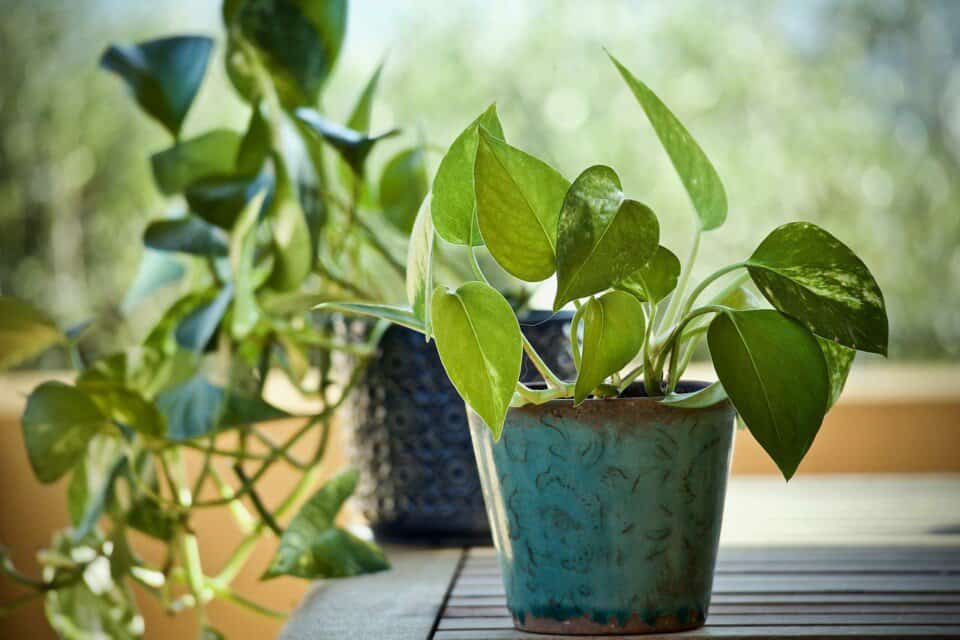Some links in the post are affiliate links and I get a commission from purchases made through some links found in the post.
Pothos is an aesthetically refreshing plant belonging to a genus of flowering plants in the family that goes by the name Arcae.
The pothos is indigenous to many regions including China, the Indian Subcontinent, Australia, New Guinea, Southeast Asia, and various islands of the Pacific and Indian Oceans.
The pothos is often spotted in homes and offices because of its beauty which is mainly contributed by its thick, waxy, green, heart-shaped leaves.
This plant can also be kept outdoors. It can be hung on elevated platforms or even become a climber if it finds a vertical support for itself.
Research and studies have shown us that taking care of the pothos is not a difficult task. It is rather simple to keep the plant in good condition.
But it is possible that sometimes, due to minor or major reasons your pothos may start to look different. It can be tricky to figure out what went wrong and why is your plant not appearing like its usual self.
One of the ways your pothos’ appearance might change is when its leaves start drooping. Like mentioned above, the leaves are the most attractive part of the plant so seeing them become drooped will alarm its caretaker.
The reasons your pothos will start drooping is:
1) Underwatering
2) Lighting
3) Overwatering
4) Temperature & Humidity
5) Fertilizer
6) Transplant Shock
7) Pests
8) Drainage
9) Root Space
10) Lack of support
Let’s explore some of the prominent factors that adversely affect the leaves of your pothos and make them look droopy.
Why is my Pothos Drooping?
1) Underwatering
 The amount of water you give your plant plays an important role in its wellbeing. Underwatering a plant is when it is not given enough water.
The amount of water you give your plant plays an important role in its wellbeing. Underwatering a plant is when it is not given enough water.
Its need is higher than what it is being given. This will result in your pothos drooping. This is a symptom of being underwatered.
The leaves and vines appear bendy and limp as result of the shortage of water in the cellular structures of the plant. Water helps to keep the leaves taut and upright.
You may also witness in the after some time of underwatering the pothos that its leaves are turning yellow. This is yet another indication by your plant that it needs more water.
The underwatering can be detected by checking the soil of your plant.
Even though it is recommended to wait for the pothos soil to dry out about 1 to 2 inches from the top before you water it again, do not let it dry to a point where it becomes cracked or begins to move away from the edges.
Leaves of your pothos may become crispy. This is when they are extremely underwatered and enter survival mode. The roots carry water throughout the plant including the leaves.
This is known as transpiration. Due to underwatering, the pothos eventually lose the ability to transpire resulting in yellow or brown leaves that are crisp and lifeless.
2) Lighting
Pothos ideally need about 12 hours of indirect, bright sunlight. Giving it too much or too little light will have adverse effects on the leaves of your pothos. One of them being droopy leaves and vines.
Directly bright light can cause damage to your plant in many ways. One of them being that the leaves of the pothos end up burning.
The colour of the leaf’s changes from lush green to pale yellow. Even though direct bright light does result in larger leaves of your pothos, the internodes, which is where new roots grow from, will be smaller in size.
When given less than the optimum amount of light, you will notice the colour of the leaves fading away. The pothos may do very well in low light but it is best if they are given a moderate amount of light.
Keeping your pothos in front of an east-facing rather than a south-facing window which has a curtain would be perfect for your plant.
It will keep the leaves happy and help them thrive. Pothos, unlike most plants, does pretty good even in artificial light.
So, if your pothos is kept in an office or at a spot in your house which does not receive indirect bright sunlight, then you can use fluorescent tubes or incandescent lights to fulfil its light requirements.
A phenomenon common among many plants in phototropism. Pothos is one of these. Phototropism is when an organism grows towards a source of light.
You may notice your pothos growing in a particular direction. This can leave part of the leaves on your plant looking droopy while part of them is doing fine.
The reason being that the plant grows towards the nearest light source if it is not being provided with uniform light.
So, try to place your pothos in a spot where all parts of it get indirect, bright light. This can greatly help to prevent leaves from drooping.
3) Overwatering
Just as underwatering can be harmful for your pothos, so can overwatering it. Giving your pothos too much water can cause root rot and make the leaves droopy.
If you have been watering your pothos more than usual and your pot does not have proper drainage, then the drooping leaves are a result of overwatering.
Overwatering your pothos can make its cell explode which makes the leaves limp and droop. After a certain point, roots are unable to absorb more water, so water is pushed out from leaves in the form of moisture.
This is when the cell walls of the leaves begin to break down, making your leaves look droopy and unhealthy.
Overwatering prevents the roots of the pothos from getting oxygen. This ends up stressing the plant and makes leaves droopy.
It can also lead to root rot and that can be seriously harmful for your plant. If the root rot is not detected early on, it may destroy your plant altogether.
4) Temperature & Humidity
 Temperatures in the range of 70-90°F (21-32°C) will be perfect for your plant. Your pothos will not do well in temperatures below 12°C and above 32°C and its leaves will start to look unhealthy and droopy.
Temperatures in the range of 70-90°F (21-32°C) will be perfect for your plant. Your pothos will not do well in temperatures below 12°C and above 32°C and its leaves will start to look unhealthy and droopy.
When temperatures fall below 50°F your pothos leaves will start to show signs of cold weather damage which includes discolouration and wilting.
The pothos leaves are not at all frost tolerant and if temperatures fall further, they will most likely end up dying. So, make sure to keep them warm when temperatures drop too low.
Changing its location to a warmer spot or closing open windows during cold spells can help to keep your pothos safe and sound.
When it comes to humidity, the pothos prefer high levels of humidity as they are native to regions with tropical climates.
Lack of humidity in the air around your pothos will make its leaves begin to droop. If your plant is indoors, you could place a humidifier or a bowl of water near your pothos as most homes and offices are naturally dry.
This will increase the amount of water vapour in the air around the pothos and provide it with the level of humidity it requires.
5) Fertiliser
When it comes to fertilising the pothos, you should keep in mind that it should not be over or under fertilised.
The common misconception is that the more we fertilise a plant, the better it will be for its growth and wellbeing. This might be true for some plants but pothos is not one of them. It does not need a lot of fertilisers.
Fertilising provides your pothos with additional micro and macro nutrients which the soil and water may not be providing it with.
Their lack can slow down leaf growth in pothos. You will also notice the leaves losing its variegation, becoming droopy and yellow brown in colour.
Try to focus on fertilising your pothos with an adequate amount of good quality fertiliser every 4 to 6 weeks.
On the other hand, try not to over fertilise the pothos as it tends to burn the leaves, makes them weaker and changes its colour from lush green to brown.
The health of the leaves deteriorates if not provided with the appropriate number of fertilisers at the correct time.
It is said that fertilising the pothos from Spring through summers at regular intervals and then reducing the frequency during the winter will do wonders for your beautiful, evergreen pothos.
6) Transplant shock
Transplanting means taking your plant out of where it was and repotting it at a new location. When we transplant a pothos, its roots sometimes go through a period of shock because of the transplantation.
During this time, it may be noticed that the leaves of the pothos are drooping. Give your plant a few weeks to adjust to the repotting and go back to the way it used to be.
In the meanwhile, while the roots are still adapting, your pothos will lose leaves and even become slightly yellow-ish in colour.
This is not something to worry about as when the roots have recovered, the leaves will be back to their normal lush green shade.
Usually this takes a few weeks. However, if the condition of the leaves does not get better after this time, then something else might be wrong with your pothos.
7) Pests
 Pests are harmful for pothos, and they make its leaves become droopy and wilted.
Pests are harmful for pothos, and they make its leaves become droopy and wilted.
Among the common pests that affect the pothos are spider mites, mealy bugs, and aphids. They suck on the sap of pothos which in turn stress and weaken the plant roots and leaves.
Mealy bugs are like furry white cotton balls, and it is rather easy to spot them on your plant. You can remove them either by picking them with alcohol swabs or you can simply use a pesticide.
Spider mites are smaller and more difficult to notice. An easy way to get rid of them is by spraying your pothos with lukewarm water with salt mixed in it.
Even if you just keep the surroundings of your pothos humid, the spider mites may go away as they dislike humidity.
Use of insecticides will also help to get rid of these unwanted insects and pests on your pothos. Good fertilisation of your pothos can also be helpful as it keeps the plant strong and healthy to fight such attacks.
8) Drainage
Pothos in pots require its soil to be properly drained. This means that it should not be given an excess amount of water and any water given to the plant should be allowed to drain off.
Pothos dislike standing in water as it easily gets root rot. So, it should be made sure that once you have given water to your pothos, it is allowed to dry a couple of inches from the top before watering it again.
Root rot can be another cause for droopy leaves in your plant. It also makes the leaves look very dull with brown spots appearing on them.
The pot you keep your pothos in should have several large drainage holes. This will prevent the soil from becoming waterlogged.
Any excess water will drain off from these holes, keeping your plant’s soil in condition. Another way to give your pothos’ soil good drainage is by mixing it with pumice or perlite.
The drainage of your soil is especially important for your pothos when it has been transplanted.
It is recommended to take a bigger pot than before to transplant your pothos into. It should also have plenty of drainage holes to keep the soil in optimum conditions.
9) Root space
The pothos can become root bound. Root bound means that the plant’s roots form a dense, tangled mass or ball which prevents them from growing further.
Roots can become root bound due to a lack of space if their size has become too big for the pot or space they are in and are constricted for an extended period.
The root bound causes hindrance in the absorption of oxygen, nutrients, and water. There are only so much the roots can take in, given the space within which they are confined.
Due to this very reason, the pothos start to become droopy. As they are not being provided with proper nutrition, the pothos start to droop and leaves tend to curl up and wilt easily. You may also notice the rest of the plant having stunted growth.
The pothos will save energy until it is transplanted to a container which will fit in the roots of the plant.
10) Lack of support
The pothos can be trained to become a climber. Providing your pothos with a vertical support will most likely make them latch onto it.
The pothos will soon start growing upwards on the support. This is known to result in a lusher and healthier plant with more attractive and larger leaves.
Final Thoughts
 Pothos is a beautiful evergreen climber which is native to China, the Indian subcontinent and many more regions around the world.
Pothos is a beautiful evergreen climber which is native to China, the Indian subcontinent and many more regions around the world.
The plant has large, waxy green leaves which are the main attraction of the pothos. The pothos is not one of the plants which require intense or special care. It just needs some basic care taking to thrive.
One of the problems that arise when taking care of pothos is drooping. There are many contributing factors for pothos becoming droopy.
Overwatering and underwatering are one of the main reasons for the drooping leaves of pothos. Overwatering suffocates the plant roots due to water becoming stagnant in the soil.
This prevents the roots from absorbing nutrients and oxygen while they absorb more water than needed.
As a result, it is lost from leaves as moisture, making them look droopy, soft, and wilted. Underwatering on the other hand will make soil cracked and dry which prevents the plant from performing transpiration.
Light is another major factor that affects the leaves in pothos. Giving the plant direct, bright light can cause the leaves to be burnt and damaged. This changes their outlook and makes the leaves droop.
While on the other hand, lack of light may not do a lot of harm but giving your pothos indirect, bright light for up to 12 hours a day is best for the wellbeing of the pothos and prevents it from becoming droopy.
Temperature and humidity can be factors that make your pothos droopy. When it comes to temperatures, higher than optimum temperatures may not do much harm to your pothos than lower temperatures can do.
Below 50 degrees Fahrenheit you will notice your leaves turning yellow in colour and becoming less taut. While frosts and freezing temperatures can be deadly for your pothos.
Other than these major factors that affect pothos drooping, there pest infestation which can cause harm and eventually damage your pothos by making it droop.
Too much or too little fertilisation or lack of drainage and its related issues can also result in poor health of your pothos. Another factor which is worth mentioning is root bound.
Roots become tangled and dense as their size increases and the space they are in becomes limited for them. This can also result in pothos drooping.
To sum it all up, the first step to prevent your pothos from drooping is to identify the reason why it is happening. If you manage to figure that out, then fixing the problem will not be difficult!

